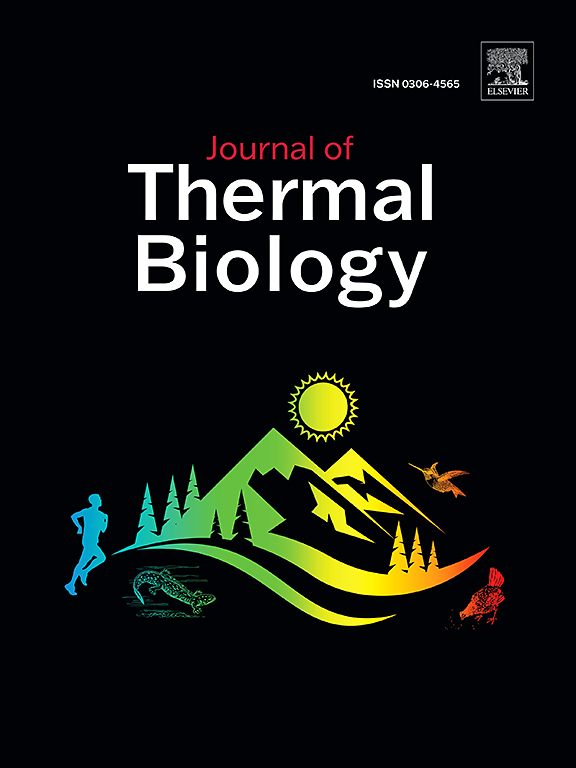使用塑料作为筑巢材料会改变孵化温度和行为,但不会影响黄腿鸥雏鸟
IF 2.9
2区 生物学
Q2 BIOLOGY
引用次数: 0
摘要
最佳孵化温度对胚胎的发育和存活至关重要。随着塑料在海鸥巢中的使用越来越多,了解塑料对孵化温度、亲鸟行为和孵化成功率的影响至关重要。有鉴于此,我们进行了一项将塑料引入黄腿鸥(Larus michahellis)巢穴的实验。实验包括三组:对照组、低塑料含量组和高塑料含量组。这种设计使我们能够研究塑料对以下方面的影响:1)孵化成鸟的心率;2)成鸟离开巢穴的次数和持续时间;3)成鸟的存在与否对鸟蛋温度的影响;4)雏鸟孵化成功率、生理参数和喙色表型。我们观察到,塑料巢的孵化温度一直较高。在温度升高时,低塑料组的缺巢次数较多,但两个塑料组的缺巢持续时间都明显低于对照组,这可能是为了减轻热应激的影响。在环境温度较高时,高塑料组的心率较高。随着环境温度的升高,低塑料组心率的增加不那么明显。对孵化成功率和幼雏的健康状况没有观察到明显的影响,但两个塑料组的血红蛋白值都很高,这可能表明雏鸡脱水。本文章由计算机程序翻译,如有差异,请以英文原文为准。
Plastic use as nesting material can alter incubation temperature and behaviour but does not affect yellow-legged gull chicks
Optimal incubation temperature is crucial for embryos' development and survival. With the increasing use of plastics in gulls' nests, it is essential to understand how their incorporation affects incubation temperature, parental behaviour, and hatching success. Considering this, we conducted an experiment where plastic was introduced into yellow-legged gulls (Larus michahellis) nests. The experiment comprised three groups: a control group, a group with low amount of plastic, and a third with a high amount of plastic. This design allowed us to investigate the effects of plastic on 1) the heart rate of incubating adults, 2) the number and duration of adults' absences from their nest, 3) how the presence or absence of the adult influenced egg temperature, and 4) chick hatching success, physiological parameters, and bill colour phenotype. We observed that incubation temperature was consistently higher in nests with plastic. The number of absences was higher in the low plastic group at increased temperatures, though the duration was significantly lower in both plastic groups than in the control, possibly to mitigate the effects of heat stress. During higher environmental temperatures, heart rate was higher for the high plastic group. The increase in heart rate in the low plastic group was less pronounced with increasing environmental temperatures. No significant effects were observed on hatching success or in the health condition of young chicks, except for high values of haemoglobin in both plastic groups, which might indicate dehydration.
求助全文
通过发布文献求助,成功后即可免费获取论文全文。
去求助
来源期刊

Journal of thermal biology
生物-动物学
CiteScore
5.30
自引率
7.40%
发文量
196
审稿时长
14.5 weeks
期刊介绍:
The Journal of Thermal Biology publishes articles that advance our knowledge on the ways and mechanisms through which temperature affects man and animals. This includes studies of their responses to these effects and on the ecological consequences. Directly relevant to this theme are:
• The mechanisms of thermal limitation, heat and cold injury, and the resistance of organisms to extremes of temperature
• The mechanisms involved in acclimation, acclimatization and evolutionary adaptation to temperature
• Mechanisms underlying the patterns of hibernation, torpor, dormancy, aestivation and diapause
• Effects of temperature on reproduction and development, growth, ageing and life-span
• Studies on modelling heat transfer between organisms and their environment
• The contributions of temperature to effects of climate change on animal species and man
• Studies of conservation biology and physiology related to temperature
• Behavioural and physiological regulation of body temperature including its pathophysiology and fever
• Medical applications of hypo- and hyperthermia
Article types:
• Original articles
• Review articles
 求助内容:
求助内容: 应助结果提醒方式:
应助结果提醒方式:


